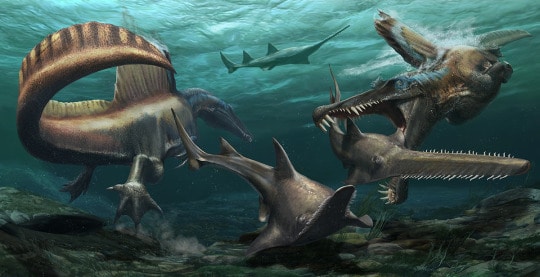
The Strange Saga of Spinosaurus, the Semiaquatic Dinosaur Superpredator
Spinosaurus is one of the most fascinating and mysterious dinosaurs ever discovered. Known for its distinctive sail-like structure and semi-aquatic adaptations, it was a true giant of the Cretaceous period. Measuring up to 15 meters (49 feet) long, it may have been even larger than Tyrannosaurus rex, making it one of the biggest carnivorous dinosaurs ever to roam the Earth.

Credits to Mark P.Witton for his reconstruction of Spinosaurus in 2020.
A Unique Predator
Unlike most theropods, Spinosaurus was likely specialized for hunting in water. Fossil evidence suggests it had a long, crocodile-like snout filled with conical teeth, ideal for catching slippery prey such as fish. Its elongated body, paddle-like feet, and dense bones indicate that it spent much of its time wading through rivers or even swimming, making it one of the first known semi-aquatic dinosaurs.

Two Spinosaurus invite the sawfish Onchopristis numidus to lunch in what’s now northern Africa some 95 million years ago. Look at those fin-like Spinosaurus tails! Credit: Davide Bonadonna/National Geographic.
The Purpose of the Sail
One of the most striking features of Spinosaurus is the tall sail on its back, formed by elongated neural spines. While its exact function is still debated, some scientists believe it was used for thermoregulation, helping the dinosaur absorb or release heat. Others suggest it may have played a role in display, either for attracting mates or intimidating rivals.

Spinosaurus alongside giant fish from the Early Cretaceous for scale. This massive predator may have evolved its large size to hunt equally large prey. As the only known semi-aquatic dinosaur, Spinosaurus likely spent most of its time in the water, surfacing mainly for nesting. Its distinctive sail may have played a role in thermoregulation, helping it maintain body temperature while submerged. Unlike other theropods, it may have relied more on a quadrupedal stance rather than walking fully upright. Credits unknown.
A Changing Image
Since its discovery in 1912, Spinosaurus has undergone several reinterpretations. Early reconstructions depicted it as a bipedal, land-dwelling predator similar to T. rex. However, more recent fossil evidence, including a newly analyzed tail, suggests that it was far more adapted to an aquatic lifestyle than previously thought. This has reshaped how scientists view its behavior and environment.

The evolution of Spinosaurus by @ttorroo on Instragram
The Mystery Continues
Despite recent discoveries, Spinosaurus remains a puzzle. Fossils are rare, and much of the original material was destroyed during World War II. Each new find brings scientists closer to understanding this incredible dinosaur, but many questions remain unanswered. Was it a true swimmer, or did it mainly hunt in shallow waters? How did it compete with other large predators of its time? As more fossils are uncovered, the story of Spinosaurus continues to evolve.

In February 2000, researchers in Egypt’s Bahariya Oasis uncovered the incomplete left humerus of Paralititan stromeri, one of the largest sauropods ever found. While the expedition yielded little Spinosaurus material, Paralititan was a remarkable discovery. A cast of its complete right humerus is now displayed at the Carnegie Museum of Natural History. (Credit: Josh Smith)

2 comments
Kunda khurd nurpur road Jilla Bijnor
Super